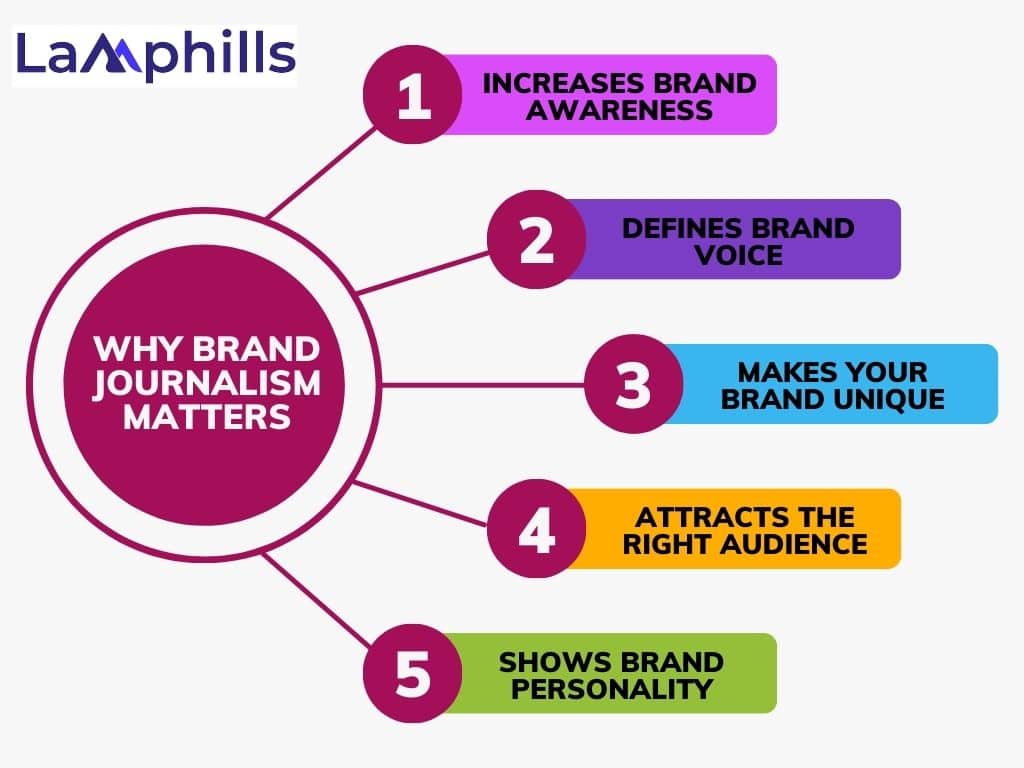I remember clearly the day I discovered the power of brand journalism. I was working on a project for a small tech startup struggling to stand out in a crowded market. They had a great product, but their usual marketing efforts weren’t working. That’s when I suggested brand journalism.
Instead of just using ads and press releases, we started creating engaging, informative content that resonated with their audience. We interviewed the founders, explored their challenges, and showcased their innovative solutions. The result? A significant increase in interest and engagement that traditional marketing couldn’t achieve. This experience convinced me of the power of brand journalism, and I’ve been a strong advocate ever since.
In this article, I’m going to talk about my experiences in brand journalism and explain everything you need to know about it. Let’s get started!
Read Also: How to Become a Journalist Even Without Experience: An Insider’s Guide
Key Points
- Unlike traditional marketing, which promotes products or services, brand journalism focuses on creating a narrative that engages and informs the audience.
- Brand journalism tells your company’s story in a way that builds trust and shows your brand’s value.
- Effective brand journalism focuses on providing useful content, using engaging visuals, having a strong presence across multiple platforms, and continuously tracking and adapting strategies based on feedback.
- To implement Brand Journalism in your strategy, first define your brand’s story. What makes your brand unique? What values do you stand for? Once you have a clear narrative, create a content plan that aligns with your brand’s goals and audience interests.
Read also: BRAND RESONANCE: Elevating Brand Resonance Through Experiential Engagement
What is Brand Journalism?
Brand journalism uses journalistic techniques to tell a brand’s story. Unlike traditional marketing, which promotes products or services, brand journalism focuses on creating a narrative that engages and informs the audience. It’s about making content people want to read, watch, or listen to.
Think of it as a mix of journalism and marketing. You’re not just selling; you’re storytelling. These stories can be about your company’s history, the people behind your brand, industry trends, or customer success stories. The goal is to provide value and build trust with your audience.
Read: Video Storytelling: Its Benefits to Your Brand
Why Brand Journalism Matters
Today, consumers are overwhelmed with ads. To stand out, brands need to offer something meaningful. That’s where brand journalism comes in. It’s not just about spreading your message; it’s about creating a connection with your audience.
When I worked with Niya Collection, a perfume distributor, we faced a similar challenge. Instead of just promoting our products, we shared stories about perfume-making, the unique ingredients we use, and the personal journeys of our perfumers. This approach not only increased our brand’s visibility but also built a loyal customer base that felt connected to our story.

Brand journalism tells your company’s story in a way that builds trust and shows your brand’s value. The importance include:
#1. Increases Brand Awareness
Brand awareness is a marketing term that describes the degree of recognition of a product by the consumer based on its name. Building brand awareness is an important step in promoting a new product or revitalizing an old brand. Ideally, brand awareness can include the characteristics that distinguish the product from its competition.
Brand journalism helps more people learn about your brand by sharing interesting and engaging stories.
Read more about Brand Awareness
#2. Defines Brand Voice
A brand voice is the clear and unique personality your brand shows in all messages, shaping how customers see you. Brand Journalism sets the style and personality of your brand’s communication, making it consistent and recognizable.
Like people, brands also have unique ways of expressing themselves. Some are welcoming, others are humorous, still, others are steadfastly professional, and still others are aspirational. Establishing a brand voice and maintaining it throughout all touchpoints, marketing initiatives, and client interactions is crucial. A strong brand voice helps to establish your company’s identity, and any deviations could hurt how people view your company.
For the best strategy, business branding agencies carefully assess your market, clientele, and company culture.
Learn more about Brand Voice
#3. Makes Your Brand Unique
Brand identity is what makes your brand stand out and be easily recognized and understood by people without confusing it with other brands. Through storytelling, it highlights what sets your brand apart from competitors, showing its unique qualities and values.
It is crucial to convey why choosing your business is the best option. You can not expect to succeed, especially if you are a startup or small business, without setting yourself apart from similar rivals, the majority of whom have likely been in operation for much longer.
Find out how you can make your Brand Unique
#4. Attracts the Right Audience
A target audience is a group of consumers a business is trying to reach through advertising/marketing. In more simple terms, it is the group of people you want to reach with your marketing efforts.
Your target audience may be a niche or broad, depending on what you market. If you were selling shoes, for example, your target audience would be diverse because men, women, and children all wear shoes. Perhaps, on the other side, you specialize in high-performance sports shoes. Then your target market would be more specialized — elite athletes aged 20 to 40 who have expressed an interest in running or who have completed a marathon. In either case, it’s critical to define and categorize your target demographic so you can figure out what kind of creative messaging would resonate with them and which channels they favor.
Brand journalism builds trust with your audience, influences their perception and conversation about your brand, and offers them an inside look at your business. It draws in people who are genuinely interested in what your brand offers, helping to build a loyal following.
Learn more about target audience
#5. Shows Brand Personality
Simply put, brand personality is the sum of a brand’s emotional, psychological, and behavioral tendencies that remain distinct over the duration of its lifecycle. They are the human characteristics and traits to which customers can relate. The personality of a brand is an aspect of its identity. It can be communicated through tone of voice, communication style, and actions, as well as deliberately building consumer impressions through in-market communications.
Brand personality is how your company shows its character through its voice, values, beliefs, and appearance, making customers feel a certain way when they interact with your business. By telling authentic stories, brand journalism reveals the human side of your brand, making it more relatable and trustworthy.
See more on the Importance of Brand Personality
Just as a comprehensive press release can boost your brand’s presence in the media, effective brand journalism can establish your company as a trusted leader in your industry.
Key Elements of Effective Brand Journalism
Effective brand journalism focuses on providing useful content, using engaging visuals, having a strong presence across multiple platforms, and continuously tracking and adapting strategies based on feedback. Here are the main elements:
1. Authenticity: Be genuine. Share real stories and experiences. When we shared the story of our perfumers, it wasn’t just marketing, it was a true look into their craft.
2. Audience Focus: Understand your audience. What are their interests and needs? Create content that speaks directly to them. For HR Improve, my HR platform, we focused our content on common HR challenges, providing practical solutions and expert insights.
3. Engaging Storytelling: Good stories are compelling and memorable. Use narrative techniques to draw your audience in. When writing about the tech startup, we framed their journey as a David-and-Goliath story, which resonated with readers.
4. Consistency: Consistency is key to building a strong brand presence. Maintain a consistent tone and voice across all stories to strengthen your brand identity and recognition. This consistency helped us at Niya Collection establish a reliable and recognizable brand voice.
5. Useful Content: Share helpful information that shows your brand’s expertise and importance in the industry.
6. Visual Appeal: Use high-quality images, videos, and infographics to make your stories more engaging.
7. Multi-Platform Presence: Share stories on social media, blogs, and news sites to reach more people.
8. Track and Adapt: Monitor how your stories perform and adjust your strategy based on feedback and data to improve results.
By focusing on these elements, you can effectively use brand journalism to create content that aligns with your audience, builds your brand’s identity, and drives engagement.
Implementing Brand Journalism in Your Strategy
Start by defining your brand’s story. What makes your brand unique? What values do you stand for? Once you have a clear narrative, create a content plan that aligns with your brand’s goals and audience interests.
Use various formats; blogs, videos, podcasts, and social media posts, to keep your content fresh and engaging. For example, at HR Improve, we diversified our content to include expert interviews, case studies, and how-to guides, which helped us reach a broader audience.
Measuring the Impact of Brand Journalism
To measure your brand journalism efforts, track key metrics such as engagement, website traffic, and social media shares. For the Niya Collection, we saw a significant increase in social media followers and website visits after implementing our brand journalism strategy.
Also, pay attention to feedback. Are people talking about your content? Are they sharing it? Positive feedback and word-of-mouth referrals are strong indicators of your content’s impact.
Read Also: HOW TO MEASURE BRAND AWARENESS: Tips To Improve Your Brand Strategy
How do Big Companies use Brand Journalism?
Here are some real examples to show how businesses do it.
Coca-Cola
Coca-Cola uses its online magazine, “Coca-Cola Journey,” to share interesting stories that go beyond regular marketing. The magazine includes articles on community work, sustainability, employee highlights, and product updates. By showcasing its social and environmental efforts, Coca-Cola builds a good reputation and shows its dedication to important causes. The platform also allows for direct interaction with the audience through comments and discussions, increasing engagement. Overall, Coca-Cola’s approach helps build trust and loyalty by consistently offering valuable and interesting content.
Intel
Intel uses brand journalism to create and share compelling stories that highlight their technology’s impact on society. Through their online platform, Intel Newsroom, they publish articles, videos, and blogs about innovation in areas such as AI, 5G, and computing. They focus on real-world applications and success stories, showcasing how Intel’s technology drives progress in various industries. This approach helps build a narrative around Intel as a leader in technological advancements, fostering a deeper connection with its audience. By emphasizing the human and societal benefits of their innovations, Intel enhances its brand reputation and engages stakeholders more effectively.
Microsoft
Microsoft has a website called “Stories” that looks like a magazine. It shows photos and videos about the company’s activities and addresses social issues.
Microsoft’s “AI for Good” program, featured on its “Stories” website, highlights projects using artificial intelligence to tackle global issues like environmental sustainability, healthcare, and humanitarian efforts.
One notable project involves using AI to predict and prevent blindness in developing countries. Microsoft’s AI tools analyze medical data to detect early signs of vision problems, enabling timely intervention. This initiative demonstrates the practical uses of AI and has boosted interest and support for Microsoft’s AI solutions, showcasing how technology can improve lives.
Ahrefs
Ahrefs, a top SEO tool provider, uses brand journalism to engage and educate its audience. Their blog and YouTube channel feature detailed articles and videos on SEO, digital marketing, and content strategy. By sharing expert insights, case studies, and practical tips, Ahrefs positions itself as a trusted industry leader. They use real-world examples and data-driven content to showcase their expertise and build trust. This approach helps Ahrefs maintain a strong brand presence and creates a loyal community of users who rely on their valuable information.
Intercom
Intercom uses brand journalism to connect with its audience by sharing engaging stories on its blog, “Inside Intercom.” They post articles, interviews, and podcasts about industry trends, customer success stories, and insights from experts. This content showcases Intercom’s knowledge and innovation, providing useful information to users and potential customers. By focusing on storytelling and relevant topics, Intercom builds trust and positions itself as a leader in customer communication, helping to create a community and strengthen brand loyalty.
Cisco
Cisco uses brand journalism to connect with its audience by sharing interesting stories on its platform, “The Network.” This platform includes articles, videos, and podcasts on topics like technology trends, company updates, and human interest stories. Cisco emphasizes storytelling to show how its tech solutions address real-world problems and foster innovation. By creating high-quality, informative content, Cisco builds trust and credibility with its audience. This method helps establish Cisco as a leading expert in the tech industry while keeping its customers engaged and informed.
Red Bull
Red Bull uses brand journalism to create exciting content that connects with its audience and fits its energetic image. Through its media arm, Red Bull Media Network, the company produces top-quality articles, videos, and documentaries about extreme sports, adventure, and lifestyle. They cover events like Red Bull Stratos, where a skydiver broke the sound barrier, attracting massive global media attention. Red Bull’s content is informative and entertaining, not just promotional, making the brand a leader in the extreme sports community. This approach boosts brand loyalty and attracts a wider audience by offering valuable and thrilling content.
Difference Between Content Marketing and Brand Journalism
Content marketing and brand journalism are both valuable strategies for engaging audiences, but they have distinct purposes and approaches.
Content Marketing:
1. Purpose: The primary goal of content marketing is to attract and retain customers by creating and sharing valuable, relevant, and consistent content. It aims to drive profitable customer action.
2. Focus: It focuses on the needs and interests of the target audience, providing solutions, insights, and entertainment to build trust and loyalty.
3. Content Types: Blog posts, eBooks, videos, infographics, webinars, and social media posts.
4. Tone: Often more promotional, with a focus on encouraging specific actions like subscribing, downloading, or purchasing.
5. Measurement: Success is measured through metrics like lead generation, conversion rates, website traffic, and social media engagement.
Brand Journalism:
1. Purpose: The primary goal of brand journalism is to tell the story of the brand in a journalistic style. It aims to build a narrative around the brand’s values, history, and mission.
2. Focus: It focuses on storytelling and creating a narrative that enhances the brand’s image and reputation, often through a more neutral, informative perspective.
3. Content Types: Feature articles, interviews, documentaries, and in-depth reports.
4. Tone: Typically less promotional and more objective, providing valuable insights and stories that enhance the brand’s credibility and trustworthiness.
5. Measurement: Success is measured through metrics like brand awareness, audience reach, media mentions, and audience sentiment.
Key Differences:
- Objective: Content marketing aims to drive customer action, while brand journalism focuses on building the brand’s story and reputation.
- Approach: Content marketing is more promotional, while brand journalism takes a journalistic, story-driven approach.
- Metrics: Content marketing looks at direct engagement and conversion, whereas brand journalism focuses on long-term brand perception and awareness.
Conclusion
If your business wants to share an interesting and useful story, brand journalism can help you. Brand journalism is not just a trend; it’s the future of marketing. As consumers become more discerning, they seek brands that offer transparency, authenticity, and value. By embracing brand journalism, you can build stronger connections with your audience and stand out in a crowded market.
My journey with brand journalism has been incredibly rewarding. From the tech startup that found its voice to Niya Collection’s storytelling, I’ve seen firsthand how powerful this approach can be. If you’re looking to boost your brand, I encourage you to give brand journalism a try. It just might transform your business.
Bonus Answers to Frequently Asked Questions
How much does branded content cost?
Finding publisher rates can be confusing. They range from $250-$750 to $1,500-$6,000 or more, with many factors influencing the cost. At Zoe Marketing & Communications, we’ve handled thousands of successful sponsored article campaigns and are here to help clarify these rates.
How many followers do you need for branded content?
They don’t specify the exact number of followers or engagement rates needed. However, you likely need around 10,000 followers, as many of Instagram’s creator features require at least that number.
What does a Brand Journalist do?
A brand journalist writes stories about a company to capture and keep an audience’s attention. They gather and edit company stories and share them through different media platforms.
What are the examples of Brand Journalism?
1. Airbnb’s “When Strangers Meet” campaign shared real customer stories without trying to sell anything.
2. Starbucks created a multimedia platform to share brand stories, industry news, and their commitments to people, the planet, and coffee.
What knowledge do you need to be a journalist?
Broadcast journalists need strong writing skills because their job includes a lot of writing, researching, creating scripts, generating content, and editing.
How do I prepare myself to be a journalist?
Most journalists need formal education and lots of hands-on training. While a journalism degree isn’t required, it helps develop important writing and interviewing skills and builds industry connections early on.
Related Articles:
Becoming a Science Journalist: Exploring with a Trusted Journalist
HOW TO MEASURE BRAND AWARENESS: Tips To Improve Your Brand Strategy
BRAND ASSETS: 13 Examples That Will Strengthen Your Band






